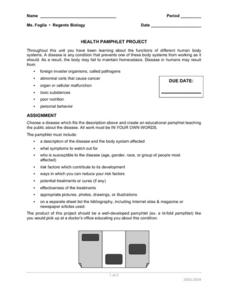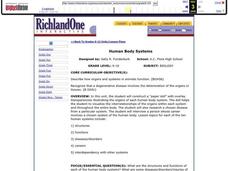Explore Biology
Health Pamphlet Project
Biology or health nuts select a disease to research and produce a pamphlet that can be used to inform the public. The tri-fold product is worth 100 points according to the included grading page.
Curated OER
Human Body Systems
Students explore the systems that comprise the human body. In this human physiology lesson plan, students create a model of the human body and research a disease from a particular system. Students will then choose to either interview a...
Curated OER
Organ Systems: Excretory, Digestive, Immune, and Nervous
Eighth graders identify and describe the components of various body systems. They create vocabulary flash cards identifying the excretory, digestive, immune, and nervous systems and describing their functions. Students complete a...
Curated OER
Health Benefits of Rice
Sixth graders examine the health benefits of rice. In this food benefits lesson, 6th graders discover the nutritious benefits of rice. Students research Celiac Sprue disease and how rice benefits the people with this disease.
Curated OER
Kirk Medical School
Fifth graders conduct research on the major organ systems of the human body. They create and present 3D models of a body system, and collect basic first-aid supplies for donation to a third-world community.
Curated OER
Recovering From Bad Eating
Students take a closer look at eating disorders. In this personal health lesson, students research common eating disorders, investigate treatments for the disorders, and make presentations that highlight their findings.
Curated OER
Alcohol and Pregnancy Don't Mix!
Seventh graders learn about John Kellerman, a youngster who was born with Fetal Alcohol Syndrome. They learn how alcohol and pregnancy doesn't mix.
Curated OER
Aerobic and Anaerobic Conditioning
Students view the A.D.A.M. computer simulation of aerobic and anaerobic exercise. They break into groups and members brainstorm and list as many aerobic and anaerobic exercises as possible in five minutes.
Curated OER
Making Blood!
students research blood's components, and use their math skills to recreate a model of whole blood using commonly found food items.








